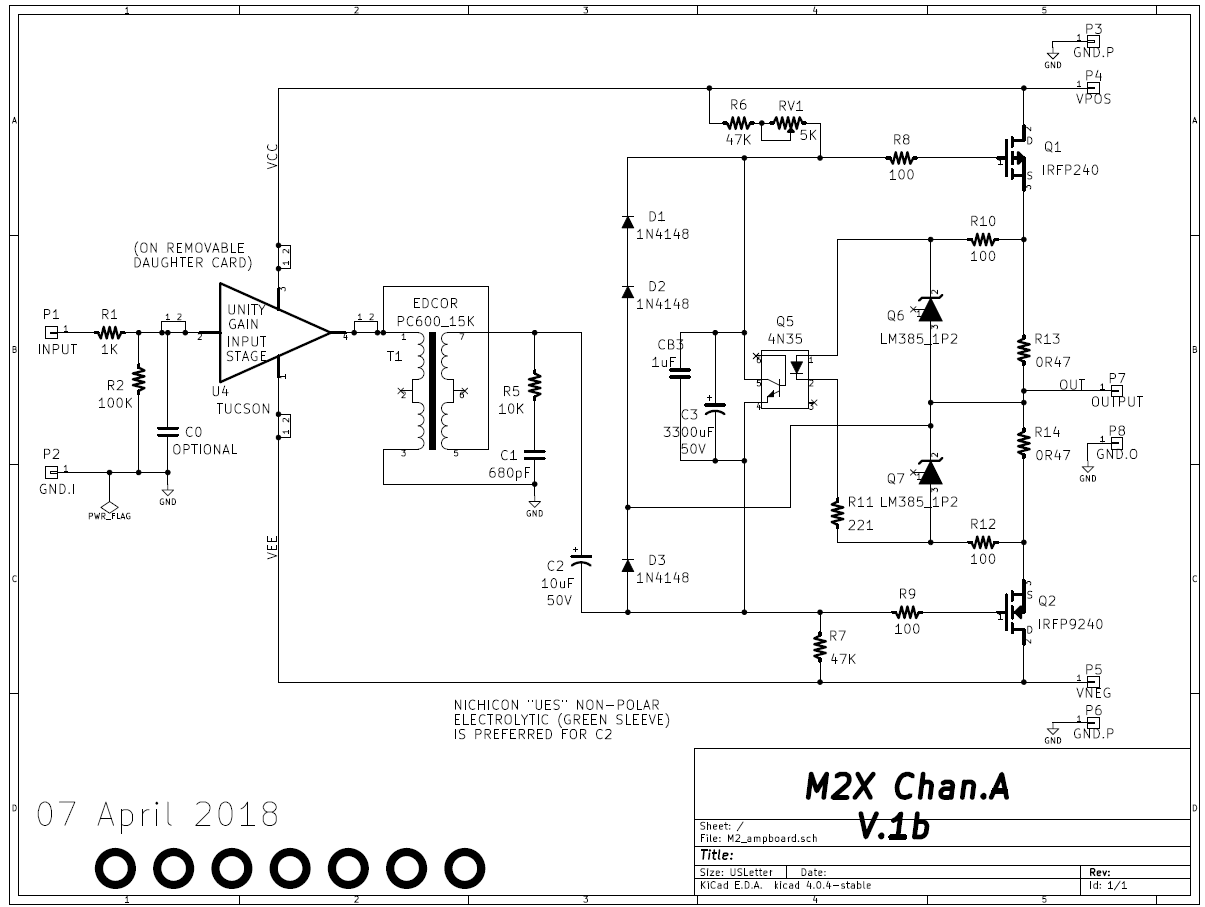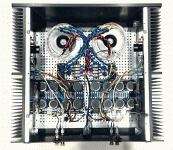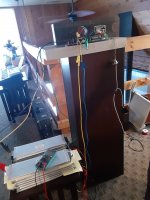A kit like that has saved the day for me, more than 20 times.
You're welcomeI see. Seems I omitted the “K” when I ordered the parts.
Thanks Plott.
I’ll have to order a couple resistors before I’m able to fix it.

I took the advice to buy a resistor kit and now my M2x is up and running. Many thanks for the help and the suggestion.
I'll let the amp burn in before commenting on sound, but have to say I feel so privileged to have access to this quality of amplifier through this forum and the store. This is my second build, following an F5. Thank you Nelson, and Mark for making this one happen.
Dual mono build in a deluxe 5U chassis.
I'll let the amp burn in before commenting on sound, but have to say I feel so privileged to have access to this quality of amplifier through this forum and the store. This is my second build, following an F5. Thank you Nelson, and Mark for making this one happen.
Dual mono build in a deluxe 5U chassis.
Attachments
This seems about right. I'm running mine on batteries, center tapped and unregulated, so the voltage steadily declines from peak. When I ran the battery down too low the amp started crashing hard, very abruptly. I checked the voltage at about 12.5. My guess is around 14v for a bare minimum. What's interesting is I did not notice any change in performance from peak voltage up until the point things fell apart. It was sounding fantastic and then there was a sudden drop in volume with heavy distortion. It was less than thirty seconds later that I grabbed the voltage measurement; however, it's entirely possible the voltage could have dropped drastically in that short time frame considering it killed three cells in the process. So 14v is just my guesstimate.Yes, I think 10 + 10V is too low.
The lowest I will be sort of comfortable with is maybe 15 + 15.
See how many ifs I inserted in this?
I personally would not go any lower than 20 + 20V.
And what is it to gain with the lower B+?
The Temptations:
"What is it good for, absolutely nothing!"
The Temptations - War - YouTube
A quick follow up on powering with center tapped battery-- I figured out a good way to do it and am using large LIFEPO4 pouch cells at 14s, center tapped, to the tune of 1.4kWh. This is the first time I have actually gotten decent power to the M2 and am totally impressed! This setup sounds much better than any of my previous amps and I haven't even started on any of the tweaks. The amp is freshly built and it really started coming to life after about a 30min warmup. I'm certain it will only keep getting better from here. BTW the battery should run two channels for about 8hrs and is good for about 2k charges cycles.This seems about right. I'm running mine on batteries, center tapped and unregulated, so the voltage steadily declines from peak. When I ran the battery down too low the amp started crashing hard, very abruptly. I checked the voltage at about 12.5. My guess is around 14v for a bare minimum. What's interesting is I did not notice any change in performance from peak voltage up until the point things fell apart. It was sounding fantastic and then there was a sudden drop in volume with heavy distortion. It was less than thirty seconds later that I grabbed the voltage measurement; however, it's entirely possible the voltage could have dropped drastically in that short time frame considering it killed three cells in the process. So 14v is just my guesstimate.
Attachments
Hi, just a short question... I listen to the amp since almost two months and noticed, that it really needs much time to sound great. After turn on there is nothing... it takes at least a couple of minutes until it works. But, in this phase is really not recommended to listen to it, somewhat distorted, with not much bass und treble... After 3-4 hours is everything okay, a gorgeous amp. Is it a normal behavior? I think yes, but who knows🙂
Cool, thanks for the confirmation.normal behaviour. Have to let the transistors warm up to get to proper bias levels.
With the optical bias control in this amplifier, my understanding was that the amplifier reached it's intended bias relatively quickly (within a minute) and auto-adjusted as-needed specifically around temperature variations. Not questioning anyone's ears or that their amp needs a few hours for them to think it sounds its best, but I didn't think that would be the mechanism with this amp.normal behaviour. Have to let the transistors warm up to get to proper bias levels.
I defer to people much smarter than I, but if you could shed some light (see what I did there
 ) on my misunderstanding, I'd be grateful. I'm still trying to understand even the simplest of these circuits.
) on my misunderstanding, I'd be grateful. I'm still trying to understand even the simplest of these circuits.Thanks!
Calculate the time required for capacitor "C3" to charge up to 95% of its final value. math hint: log_e(0.05) = -2.996

Sorry for taking this a bit OT. I think the "answer" for this is covered early in the thread, but I made an attempt. Mark, truly appreciated. I have been taking a few of the on-line electronics courses. I'm in that stage of even barely knowing what questions to ask.
I have done an initial search scouring the web and my class notes for something related to the natural log used in an equation to determine the "Time Constant" of a capacitor. I admit that I've not yet found a reference to your hint. I had something in my notes re: 100s of seconds for C3 to charge. So, my recollection of 'within a minute' is clearly not correct.
The way I had initially approached it was to use the time constant equation and assume 5 time constants for a 99% charge. Perhaps your hint that I've yet to absorb gets me to the 95% number vs. 99%. 3,300 uF x 47k (assuming I used the proper units) => TC = 155s => Assuming 5 TCs to reach 99% charge => a shade over 12 minutes.
For those in the stands observing my amateur skills, mocking is fully supported and even condoned.
So, my "guess" of within a minute is off by a factor of 12 or so, assuming I've done things even remotely correctly.
Mark, once again, I always appreciate the hints you throw out. It takes me quite a bit of time to perhaps even get close to a correct answer or the right line of thinking, when many can do it in seconds. However, applying what little bit of the classwork I've done into real situations is very worthwhile.

I have done an initial search scouring the web and my class notes for something related to the natural log used in an equation to determine the "Time Constant" of a capacitor. I admit that I've not yet found a reference to your hint. I had something in my notes re: 100s of seconds for C3 to charge. So, my recollection of 'within a minute' is clearly not correct.
The way I had initially approached it was to use the time constant equation and assume 5 time constants for a 99% charge. Perhaps your hint that I've yet to absorb gets me to the 95% number vs. 99%. 3,300 uF x 47k (assuming I used the proper units) => TC = 155s => Assuming 5 TCs to reach 99% charge => a shade over 12 minutes.
For those in the stands observing my amateur skills, mocking is fully supported and even condoned.
So, my "guess" of within a minute is off by a factor of 12 or so, assuming I've done things even remotely correctly.
Mark, once again, I always appreciate the hints you throw out. It takes me quite a bit of time to perhaps even get close to a correct answer or the right line of thinking, when many can do it in seconds. However, applying what little bit of the classwork I've done into real situations is very worthwhile.

I think the TC calculation is correct but Mark gave you the answer to charge to 95% as opposed to 99% which was 3TC so 155x3 = 465 seconds or about 7m 45s. Thanks for leading the class IAMH! 

^ AHA! Still haven't found the exact formula in my references yet. My search skills and or the resources I'm using ...
I thought that might be the case since I saw '0.05' in his equation. Thanks Twitchie!
I took a few TC rules of thumb for a charging circuit and tested them against the equation Mark provided.
log_e(0.368) => ~1 => TC => 63.2% of the charge
log_e(0.135) -> ~2 => 2TC => 86.5% of the charge
log_e(0.05) -> ~3 => 3TC => 95% of the charge (as Mark was trying to lead me to).
Turns out... they match.
Live and learn. Thanks gents!
Applied back to my original assumptions around a properly operating M2x - The bias current should be 'relatively stable' within operating parameters well before 30 minutes. So a stable bias current ... should ... not be dependent on the output devices reaching temperature equilibrium => affecting the bias current in a meaningful way - even if reaching equilibrium occurs after C3 is "charged"... I hope.
So, even though I got the timing way off, bias 'normalizing' over a period of hours shouldn't be the mechanism for Plott's observations. I think...
Love this group's willingness to teach and share.

I thought that might be the case since I saw '0.05' in his equation. Thanks Twitchie!
I took a few TC rules of thumb for a charging circuit and tested them against the equation Mark provided.
log_e(0.368) => ~1 => TC => 63.2% of the charge
log_e(0.135) -> ~2 => 2TC => 86.5% of the charge
log_e(0.05) -> ~3 => 3TC => 95% of the charge (as Mark was trying to lead me to).
Turns out... they match.

Live and learn. Thanks gents!
Applied back to my original assumptions around a properly operating M2x - The bias current should be 'relatively stable' within operating parameters well before 30 minutes. So a stable bias current ... should ... not be dependent on the output devices reaching temperature equilibrium => affecting the bias current in a meaningful way - even if reaching equilibrium occurs after C3 is "charged"... I hope.

So, even though I got the timing way off, bias 'normalizing' over a period of hours shouldn't be the mechanism for Plott's observations. I think...

Love this group's willingness to teach and share.

Last edited:
It's a little tricky because (a) the current which charges capacitor C3 flows through both R6 and R7; and also (b) the final voltage across C3 is way, Way, WAY less than |TopRailVoltage| + |BottomRailVoltage|. Meaning that specifying a 50V rated capacitor for C3 might be unnecessarily, wildly over-conservative. ZM feels this way.
After 3-4 hours is everything okay, a gorgeous amp. Is it a normal behavior?
I've had my M2X (with the Ishikawa buffer) up and running for about a week. The one thing that has shocked me is how, once the initial 35-45 seconds biasing into operation, the thing sounds fully "warmed up". Certainly not hours. Compare this with other designs like the Alephs and F6 I've built, which sound just fine on initial turn on, but after 15 minutes there's an "ooh, much better!" moment, and another around 45 minutes. That's when the F6 and Alephs really shine.my understanding was that the amplifier reached it's intended bias relatively quickly (within a minute)
My assumption is the gain transformers really don't "warm up," or if they do, nowhere near as dramatically as the transistors. We're not picking operating points from a set of curves here. We give the transformers a signal, they do their gain. So for me, the M2X is pretty much full on at one minute.
And the sound of the M2X-ishikawa is shocking to me. Very powerful, punchy, natural, yet tight, without being "bouncy." It's a very different character than I've heard before. I'm truly surprised there was never a phase of manufacturers extolling and marketing "iron-gain" as the next great fad. "Forget tubes, forget high power transistors, you want iron!" Maybe it did happen, but before my time.
Regardless, the M2 sounds amazing.
It occurred to me last night that the M2X doesn't have feedback, and that also might be a huge factor to the difference I'm hearing.
I like it!
I like it!
- Home
- Amplifiers
- Pass Labs
- The diyAudio First Watt M2x


